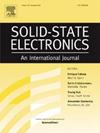Rigorous analysis on the operating mechanism of gate-injection ferroelectric flash
IF 1.4
4区 物理与天体物理
Q3 ENGINEERING, ELECTRICAL & ELECTRONIC
引用次数: 0
Abstract
In this paper, the operation mechanism of gate-injection ferroelectric flash (GI-FeFlash) is studied through technology computer-aided design (TCAD) simulations. It reveals that GI-FeFlash exhibits an extraordinarily large memory window (MW) compared to the sum of MWs of a ferroelectric field-effect transistor (FeFET) and a charge trap flash (CTF), attributed to the synergistic effects between the two mechanisms: a polarization switching and a charge trapping. These synergistic effects can be analyzed by two phenomena: 1) a trap-assisted polarization switching (TAPS) and 2) a polarization-assisted charge trapping (PACT). In the case of TAPS, the trapped charges in the charge trap layer (CTL) enhance the polarization in the ferroelectric (FE) layer by increasing the electric field of the blocking oxide (i.e., FE layer). On the other hand, in the case of PACT, the polarization in the FE layer helps the charge injection into the CTL by increasing the electric field of the tunnel oxide (TO). Furthermore, TAPS and PACT are also verified by the analytical models based on Gauss’s law. Therefore, GI-FeFlash can achieve a large MW (∼14.9 V) with a low-program/erase voltage and a fast-speed operation through the complementary relations between the two mechanisms.
对栅喷射铁电闪动的工作机理进行了严密的分析
本文通过计算机辅助设计(TCAD)技术仿真,研究了栅极喷射铁电闪光(GI-FeFlash)的工作机理。研究表明,与铁电场效应晶体管(FeFET)和电荷陷阱闪存(CTF)的MW之和相比,GI-FeFlash具有非常大的存储窗口(MW),这归因于极化开关和电荷捕获两种机制之间的协同效应。这些协同效应可以通过两种现象来分析:1)阱辅助极化开关(TAPS)和2)极化辅助电荷捕获(PACT)。在TAPS中,电荷阱层(CTL)中捕获的电荷通过增加阻塞氧化物(即FE层)的电场来增强铁电层(FE)中的极化。另一方面,在PACT的情况下,FE层的极化通过增加隧道氧化物(TO)的电场来帮助电荷注入CTL。此外,基于高斯定律的分析模型也验证了TAPS和PACT的正确性。因此,GI-FeFlash可以通过两种机制之间的互补关系,以低编程/擦除电压和快速操作实现大MW (~ 14.9 V)。
本文章由计算机程序翻译,如有差异,请以英文原文为准。
求助全文
约1分钟内获得全文
求助全文
来源期刊

Solid-state Electronics
物理-工程:电子与电气
CiteScore
3.00
自引率
5.90%
发文量
212
审稿时长
3 months
期刊介绍:
It is the aim of this journal to bring together in one publication outstanding papers reporting new and original work in the following areas: (1) applications of solid-state physics and technology to electronics and optoelectronics, including theory and device design; (2) optical, electrical, morphological characterization techniques and parameter extraction of devices; (3) fabrication of semiconductor devices, and also device-related materials growth, measurement and evaluation; (4) the physics and modeling of submicron and nanoscale microelectronic and optoelectronic devices, including processing, measurement, and performance evaluation; (5) applications of numerical methods to the modeling and simulation of solid-state devices and processes; and (6) nanoscale electronic and optoelectronic devices, photovoltaics, sensors, and MEMS based on semiconductor and alternative electronic materials; (7) synthesis and electrooptical properties of materials for novel devices.
 求助内容:
求助内容: 应助结果提醒方式:
应助结果提醒方式:


